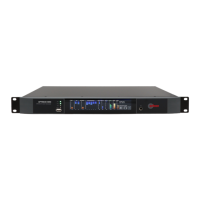Orban 5950 Technical Manual Installation 2-3
feed the STL. Then feed the output of the STL receiver directly into the transmitter’s exciter with no intervening
processing.
If an uncompressed left/right digital link is available to the transmitter, this is also an excellent means of
transmission, although it will not pass the effects of the 5950’s composite processor (if you are using it). However,
if the digital link employs lossy compression, it will degrade peak control. To prevent overshoots caused by spectral
truncation in the link, set the 5950’s output sample rate to 44.1 kHz or higher.
If only an audio link is available, use the 5950’s left and right audio outputs and feed the audio, without pre-
emphasis, directly into the link. If possible, request that any transmitter protection limiters be adjusted for
minimum possible action— THE OPTIMOD-5950 does most of that work. Transmitter protection limiters should
respond only to signals caused by faults or by spurious peaks introduced by imperfections in the link. To ensure
maximum quality, all equipment in the signal path after the studio should be carefully aligned and qualified to
meet the appropriate standards for bandwidth, distortion, group delay and gain stability and such equipment
should be re-qualified at reasonable intervals.
If the transmitter is accessible: You can achieve the most accurate control of modulation peaks by locating THE
OPTIMOD-5950 at the transmitter site and then using its stereo encoder to drive the transmitter. You can usually
also obtain good results by locating THE OPTIMOD-5950 at the studio and connecting the baseband output of its
stereo encoder to the transmitter through a composite baseband STL.
However, many analog composite baseband STLs do not control peaks perfectly and locating THE OPTIMOD-5950
at the transmitter site (where it can control peaks just prior to the transmitter’s RF exciter) is thus likely to
maximize loudness. The ideal link is an uncompressed digital composite STL because these have virtually flawless
waveform fidelity and allow full use of the 5950’s composite limiter.
Because THE OPTIMOD-5950 controls peaks, it is irrelevant whether the audio link feeding THE OPTIMOD-5950’s
input terminals is phase-linear. However, the link should have low noise, the flattest possible frequency response
from 30-15,000Hz, and low nonlinear distortion.
We strongly recommend that you use the 5950’s internal stereo encoder to feed the output of the encoder
directly. You will achieve a louder sound on the air, with better control of peak modulation, than if you use current
external stereo encoders.
The shorter the baseband cable from THE OPTIMOD-5950 to exciter, the less likely that ground loops or other
noise problems will occur in the installation. If you require a long cable run, you can use a Jensen JT-123-BMCF
transformer1 to break any ground loops. This transformer will usually cure even the most stubborn hum or noise
caused by the composite connection between THE OPTIMOD-5950 and the exciter.

